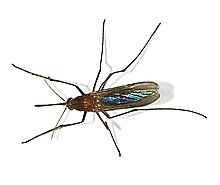Local community of action to combat the bug plague
The municipal action group to combat the Schnakenplage eV (KABS) is an association based in Speyer , which was founded in 1976 and to which 98 corporations (cities, municipalities, districts and the state of Baden-Württemberg) along the Upper Rhine belonged in 2013 and which together control mosquitoes fight in the Rhine area . "Schnaken" does not mean the gnats in the zoological sense, but mosquitoes. Aedimorphus vexans accounts for over 80 percent of the individuals of the 33 mosquito species found in the Upper Rhine . It is not uncommon for 50,000 Aedes eggs to be found in one square meter of the bank area of a flood pool.
The employees carry out the biological mosquito control over a distance of approx. 300 kilometers on the Rhine between Bingen and Offenburg on an area of around 6,000 square kilometers. Only the Bt proteins produced by Bacillus thuringiensis israelensis (BTI) are used.
The biological control takes place according to the degree of flooding, the path of the terrain or the legal requirements on foot or with helicopters. In any case, the biological active ingredient , which must not contain any living bacteria, is introduced into the brood waters of the larvae. There the active ingredient has to be eaten by the mosquito larvae. The active ingredient is only activated in the intestines of the mosquito larvae and leads to the dissolution of the intestinal cells and thus extremely selectively to the death of the animals.
distribution
The active ingredient is mixed with water and distributed with a backpack syringe by employees on foot or distributed as ice granules from the air using two helicopters. In 2007, the two helicopters and 250 helpers scattered 260 tons of pesticides in this way. This took place on 84 combat days, of which 47 days were with helicopter support. 33,000 working hours were billed and 270,000 km were covered. The resulting costs of 400,000 euros per year bring the residents a reduction of the mosquito population by 99% compared to untreated areas.
The time of use is decisive for the effectiveness. Mosquitoes lay their eggs in depressions that are higher than normal water levels. The eggs can survive there for years or even decades. If the eggs are then flooded during high water, the larvae hatch. It is therefore always essential to use it after a flood wave. It must then be used promptly within a week because only the larvae can be killed by the active ingredient.
In addition, CULINEX tablets with the active ingredient are distributed free of charge to the citizens of the KABS area for stagnant micro bodies of water in the residential areas, in particular rain barrels or garden ponds without fish. A single rain barrel can be the source of several hundred mosquitoes.
Association
Hartwig Rihm is the association's president, and Norbert Becker is the scientific director of the KABS .
The association is financed through levies (membership fees of the 98 affiliated regional authorities). For a city like Wiesbaden that means a contribution of 45,000 euros per year.
International activities
KABS also makes its specialist knowledge available internationally. Under its English name German Mosquito Control Association is a member of the European Mosquito Control Association and supported through the UN sub-organization WHO worldwide programs for mosquito control .
Current development
As flood protection is playing an increasingly important role, polders will increasingly be designated in the near future . These planned floodplains are additional breeding areas for mosquitoes and require additional work that can probably only be managed with the help of a third helicopter.
Basic criticism
The comprehensive control of mosquitoes is controversial from an ecological point of view. In 2012, the Tour du Valat Research Center in Arles concluded that BTI could have a negative impact on ecosystems and, in particular, negatively affect the food supply of birds.
A research group from the University of Koblenz-Landau also postulated negative effects of the BTI use on the ecology in their Geinsheim project , but acknowledged the lack of statistical significance of their project results. Additional environmental concerns are listed in the mosquito article .
Individual evidence
- ↑ WHO publications: Guideline Specifications for Bacterial Larvicides for Public Health Use , p. 32
- ^ Discussion about BTI in Mannheimer Morgen
- ↑ BTI Mosquito Control in the Camargue: accentuation of observed impacts on biodiversity in 2012
- ^ Gift on the Rhine (Deutschlandfunk)
literature
- Norbert Becker, Paul Glaser, Hermann Magin: Biological mosquito control on the Upper Rhine , (commemorative publication) 20 years of municipal action group to combat the snake plague, 1996, ISBN 3-00-000584-6
- Norbert Becker: Biological control of mosquitoes: management of the Upper Rhine mosquito population as a model program in Jørgen Eilenberg, Heikki MT Hokkanen (Ed.): An ecological and societal approach to biological control , Springer, 2006, pp. 227–245, ISBN 978-1-4020-4320-8 (print) ISBN 978-1-4020-4401-4 (online)
- Investigations into mosquito control with Bti on the food web: Study Geinsheim

